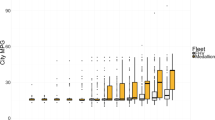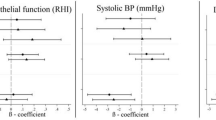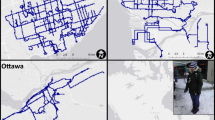Abstract
Exposure estimates that do not account for time in-transit may underestimate exposure to traffic-related air pollution, but exact contributions have not been studied directly. We conducted a 2-week monitoring, including novel in-vehicle sampling, in a subset of the Multi-Ethnic Study of Atherosclerosis and Air Pollution cohort in two cities. Participants spent the majority of their time indoors and only 4.4% of their time (63 min/day) in-vehicle, on average. The mean ambient-source NO2 concentration was 5.1 ppb indoors and 32.3 ppb in-vehicle during drives. On average, indoor exposure contributed 69% and in-vehicle exposure contributed 24% of participants’ ambient-source NO2 exposure. For participants in the highest quartile of time in-vehicle (≥1.3 h/day), indoor and in-vehicle contributions were 60 and 31%, respectively. Incorporating infiltrated indoor and measured in-vehicle NO2 produced exposure estimates 5.6 ppb lower, on average, than using only outdoor concentrations. The indoor microenvironment accounted for the largest proportion of ambient-source exposure in this older population, despite higher concentrations of NO2 outdoors and in vehicles than indoors. In-vehicle exposure was more influential among participants who drove the most and for participants residing in areas with lower outdoor air pollution. Failure to characterize exposures in these microenvironments may contribute to exposure misclassification in epidemiologic studies.
This is a preview of subscription content, access via your institution
Access options
Subscribe to this journal
Receive 6 print issues and online access
$259.00 per year
only $43.17 per issue
Buy this article
- Purchase on Springer Link
- Instant access to full article PDF
Prices may be subject to local taxes which are calculated during checkout


Similar content being viewed by others
References
Dockery DW, Pope CA 3rd, Xu X, Spengler JD, Ware JH, Fay ME, et al. An association between air pollution and mortality in six US cities. N Engl J Med. 1993;329:1753–9.
Miller KA, Siscovick DS, Sheppard L, Shepherd K, Sullivan JH, Anderson GL, et al. Long-term exposure to air pollution and incidence of cardiovascular events in women. N Engl J Med. 2007;356:447–58.
Pope CA 3rd, Burnett RT, Thun MJ, Calle EE, Krewski D, Thurston GD, et al. Lung cancer, cardiopulmonary mortality, and long-term exposure to fine particulate air pollution. JAMA. 2002;287:1132–41.
Hoek G, Brunekreef B, Goldbohm S, Fischer P, Van Den Brandt PA. Association between mortality and indicators of traffic-related air pollution in the Netherlands: a cohort study. Lancet. 2002;360:1203–9.
Ostro B, Lipsett M, Reynolds P, Goldberg D, Hertz A, Garcia C, et al. Long-term exposure to constituents of fine particulate air pollution and mortality: results from the California Teachers Study. Environ Health Perspect. 2010;118:363–9.
Gehring U, Heinrich J, Kramer U, Grote V, Hochadel M, Sugiri D, et al. Long-term exposure to ambient air pollution and cardiopulmonary mortality in women. Epidemiology. 2006;17:545–51.
Rosenlund M, Berglind N, Pershagen G, Hallqvist J, Jonson T, Bellander T. Long-term exposure to urban air pollution and myocardial infarction. Epidemiology. 2006;17:383–90.
Puett RC, Hart JE, Yanosky JD, Paciorek C, Schwartz J, Suh H, et al. Chronic fine and coarse particulate exposure, mortality, and coronary heart disease in the Nurses’ Health Study. Environ Health Perspect. 2009;117:1697–701.
Dimitroulopoulou C, Ashmore M, Byrne M, Kinnersley R. Modelling of indoor exposure to nitrogen dioxide in the UK. Atmos Environ. 2001;35:269–79.
Yamanaka S. Decay rates of nitrogen oxides in a typical Japanese living room. Environ Sci Technol. 1985;18:566–70.
Lee K, Xue J, Geyh AS, Özkaynak H, Leaderer BP, Weschler CJ, et al. Nitrous acid, nitrogen dioxide, and ozone concentrations in residential environments. Environ Health Perspect. 2002;110:145–9.
Lee K, Levy JI, Yanagisawa Y, Spengler JD, Billick IH. The Boston residential nitrogen dioxide characterization study: classification and prediction of indoor NO2 exposure. J Air Waste Manag Assoc. 1998;48:736–42.
Graham SE, McCurdy T. Developing meaningful cohorts for human exposure models. J Expo Anal Environ Epidemiol. 2004;14:23–43.
Leech JA, Nelson WC, Burnett RT, Aaron S, Raizenne ME. It’s about time: a comparison of Canadian and American time-activity patterns. J Expo Anal Environ Epidemiol. 2002;12:427–32.
US EPA. US EPA Exposure Factors Handbook 2011 Edition (Final Report), U.S. Environmental Protection Agency: Washington, DC. 2011 https://cfpub.epa.gov/ncea/risk/recordisplay.cfm?deid=236252.
US EPA. US EPA Descriptive Statistics Tables from a Detailed Analysis of the National Human Activity Pattern Survey (NHAPS) Data, U.S. Environmental Protection Agency: Las Vegas, NV, 1996.
Allen RW, Adar SD, Avol E, Cohen M, Curl CL, Larson T, et al. Modeling the residential infiltration of outdoor PM2.5 in the Multi-Ethnic Study of Atherosclerosis and Air Pollution (MESA Air). Environ Health Perspect. 2012;120:824–30.
Cohen MA, Adar SD, Allen RW, Avol E, Curl CL, Gould T, et al. Approach to estimating participant pollutant exposures in the Multi-Ethnic Study of Atherosclerosis and Air Pollution (MESA Air). Environ Sci Technol. 2009;43:4687–93.
Kaufman JD, Adar SD, Allen RW, Barr RG, Budoff MJ, Burke GL, et al. Prospective study of particulate air pollution exposures, subclinical atherosclerosis, and clinical cardiovascular disease: The Multi-Ethnic Study of Atherosclerosis and Air Pollution (MESA Air). Am J Epidemiol. 2012;176:825–37.
Kaufman JD, Adar SD, Barr RG, Budoff M, Burke GL, Curl CL, et al. Association between air pollution and coronary artery calcification within six metropolitan areas in the USA (the Multi-Ethnic Study of Atherosclerosis and Air Pollution): a longitudinal cohort study. Lancet. 2016;6736:1–9.
Chan CC, Ozkaynak H, Spengler JD, Sheldon L. Driver exposure to volatile organic compounds, CO, ozone, and NO2 under different driving conditions. Env Sci Technol. 1991;25:964–72.
Westerdahl D, Fruin S, Sax T, Fine PM, Sioutas C. Mobile platform measurements of ultrafine particles and associated pollutant concentrations on freeways and residential streets in Los Angeles. Atmos Environ. 2005;39:3597–610.
Weichenthal S, Van Ryswyk K, Kulka R, Sun L, Wallace L, Joseph L. In-vehicle exposures to particulate air pollution in Canadian Metropolitan areas: the urban transportation exposure study. Environ Sci Technol. 2015;49:597–605.
Baxter LK, Dionisio KL, Burke J, Ebelt Sarnat S, Sarnat JA, Hodas N, et al. Exposure prediction approaches used in air pollution epidemiology studies: key findings and future recommendations. J Expo Sci Environ Epidemiol. 2013;23:654–9.
Ragettli MS, Tsai MY, Braun-Fahrländer C, de Nazelle A, Schindler C, Ineichen A, et al. Simulation of population-based commuter exposure to NO2 using different air pollution models. Int J Environ Res Public Health. 2014;11:5049–68.
Kunzli N, Kaiser R, Medina S, Studnicka M, Chanel O, Filliger P, et al. Public-health impact of outdoor and traffic-related air pollution: a European assessment. Lancet. 2000;356:795–801.
Frampton MW, Boscia J, Roberts NJ, Azadniv M, Torres A, Cox C, et al. Nitrogen dioxide exposure: effects on airway and blood cells. Am J Physiol Lung Cell Mol Physiol. 2002;282:L155–L165.
Bild DE, Bluemke DA, Burke GL, Detrano R, Diez Roux AV, Folsom AR, et al. Multi-ethnic study of atherosclerosis: objectives and design. Am J Epidemiol. 2002;156:871–81.
Breen MS, Breen M, Williams RW, Schultz BD. Predicting residential air exchange rates from questionnaires and meteorology: model evaluation in central North Carolina. Environ Sci Technol. 2010;44:9349–56.
Isaacs K, Burke J, Smith L, Williams R. Identifying housing and meteorological conditions influencing residential air exchange rates in the DEARS and RIOPA studies: development of distributions for human exposure modeling. J Expo Sci Environ Epidemiol. 2013;23:248–58.
Hazlehurst MF, Spalt EW, Curl CL, Davey ME, Vedal S, Burke GL, et al. Integrating data from multiple time-location measurement methods for use in exposure assessment: the Multi-Ethnic Study of Atherosclerosis and Air Pollution (MESA Air). J Expo Sci Environ Epidemiol. 2017;27:1–6.
Son B, Yang W, Breysse P, Chung T, Lee Y. Estimation of occupational and nonoccupational nitrogen dioxide exposure for Korean taxi drivers using a microenvironmental model. Environ Res. 2004;94:291–6.
de Nazelle A, Seto E, Donaire-Gonzalez D, Matamala J, Nieuwenhuijsen MJ, Jerrett M. Improving estimates of air pollution exposure through ubiquitous sensing technologies. Environ Pollut. 2014;176:92–99.
de Nazelle A, Fruin S, Westerdahl D, Martinez D, Ripoll A, Kubesch N, et al. A travel mode comparison of commuters’ exposures to air pollutants in Barcelona. Atmos Environ. 2012;59:151–9.
Gurram S, Stuart AL, Pinjari AR. Impacts of travel activity and urbanicity on exposures to ambient oxides of nitrogen and on exposure disparities. Air Qual Atmos Heal. 2015;8:97–114.
Yamamoto N, Shendell DG, Winer a M, Zhang J. Residential air exchange rates in three major US metropolitan areas: results from the Relationship among Indoor, Outdoor, and Personal Air Study 1999-2001. Indoor Air. 2010;20:85–90.
Breen MS, Burke JM, Batterman SA, Vette AF, Godwin C, Croghan CW, et al. Modeling spatial and temporal variability of residential air exchange rates for the Near-Road Exposures and Effects of Urban Air Pollutants Study (NEXUS). Int J Environ Res Public Health. 2014;11:11481–504.
Lee JY, Ryu SH, Kim CH, Bae G-N. Indoor-to-outdoor pollutant concentration ratio modeling of CO2, NO2, and lung-deposited nanoparticles. Atmos Pollut Res. 2016. https://doi.org/10.1016/j.apr.2016.02.007
Setton E, Marshall JD, Brauer M, Lundquist KR, Hystad P, Keller P, et al. The impact of daily mobility on exposure to traffic-related air pollution and health effect estimates. J Expo Sci Environ Epidemiol. 2011;21:42–48.
Williams R, Jones P, Croghan C, Thornburg J, Rodes C. The influence of human and environmental exposure factors on personal NO2 exposures. J Expo Sci Environ Epidemiol. 2012;22:109–15.
Stroh E, Rittner R, Oudin A, Ardö J, Jakobsson K, Björk J, et al. Measured and modeled personal and environmental NO2 exposure. Popul Health Metr. 2012;10:10.
Ragettli MS, Phuleria HC, Tsai M-Y, Schindler C, de Nazelle A, Ducret-Stich RE, et al. The relevance of commuter and work/school exposure in an epidemiological study on traffic-related air pollution. J Expo Sci Environ Epidemiol. 2015;25:474–81.
Baxter LK, Burke J, Lunden M, Turpin BJ, Rich DQ, Thevenet-Morrison K, et al. Influence of human activity patterns, particle composition, and residential air exchange rates on modeled distributions of PM2.5 exposure compared with central-site monitoring data. J Expo Sci Environ Epidemiol. 2013;23:241–7.
Sheppard L, Burnett RT, Szpiro AA, Kim S, Jerrett M, Iii CAP et al. Confounding and exposure measurement error in air pollution epidemiology. Air Quality, Atmosphere and Health. 2012;5: 203–16.
South Coast AQMD. 2016 Air Quality Management Plan. 2016. http://www.aqmd.gov/docs/default-source/clean-air-plans/air-quality-management-plans/2016-air-quality-management-plan/final-2016-aqmp/final2016aqmp.pdf?sfvrsn=15.
Riediker M, Williams R, Devlin R, Griggs T, Bromberg P. Exposure to particulate matter, volatile organic compounds, and other air pollutants inside patrol cars. Environ Sci Technol. 2003;37:2084–93.
Lewné M, Plato N, Gustavsson P. Exposure to particles, elemental carbon and nitrogen dioxide in workers exposed to motor exhaust. Ann Occup Hyg. 2007;51:693–701.
Farrar D, Dingle P, Tan R. Exposure to nitrogen dioxide in buses, taxis, and bicycles in Perth, Western Australia. Bull Environ Contam Toxicol. 2001;66:433–8.
Zagury E, Le Moullec Y, Momas I. Exposure of Paris taxi drivers to automobile air pollutants within their vehicles. Occup Environ Med. 2000;57:406–10.
Patton AP, Laumbach R, Ohman-Strickland P, Black K, Alimokhtari S, Lioy PJ, et al. Scripted drives: A robust protocol for generating exposures to traffic-related air pollution. Atmos Environ. 2016;143:290–9.
Acknowledgements
This publication was developed under a STAR research assistance agreement, No. RD831697 (MESA Air), and RD83479601-01 (UW CCAR), awarded by the U.S Environmental Protection Agency and NIH NIEHS R01ES023500 (SPIROMICS Air). It has not been formally reviewed by the EPA. The views expressed in this document are solely those of the authors and the EPA does not endorse any products or commercial services mentioned in this publication.
Author information
Authors and Affiliations
Corresponding author
Ethics declarations
Conflict of interest
The authors declare that they have no conflict of interest.
Electronic supplementary material
Rights and permissions
About this article
Cite this article
Hazlehurst, M.F., Spalt, E.W., Nicholas, T.P. et al. Contribution of the in-vehicle microenvironment to individual ambient-source nitrogen dioxide exposure: the Multi-Ethnic Study of Atherosclerosis and Air Pollution. J Expo Sci Environ Epidemiol 28, 371–380 (2018). https://doi.org/10.1038/s41370-018-0025-1
Received:
Revised:
Accepted:
Published:
Issue Date:
DOI: https://doi.org/10.1038/s41370-018-0025-1
Keywords
This article is cited by
-
Measuring environmental exposures in people’s activity space: The need to account for travel modes and exposure decay
Journal of Exposure Science & Environmental Epidemiology (2023)



